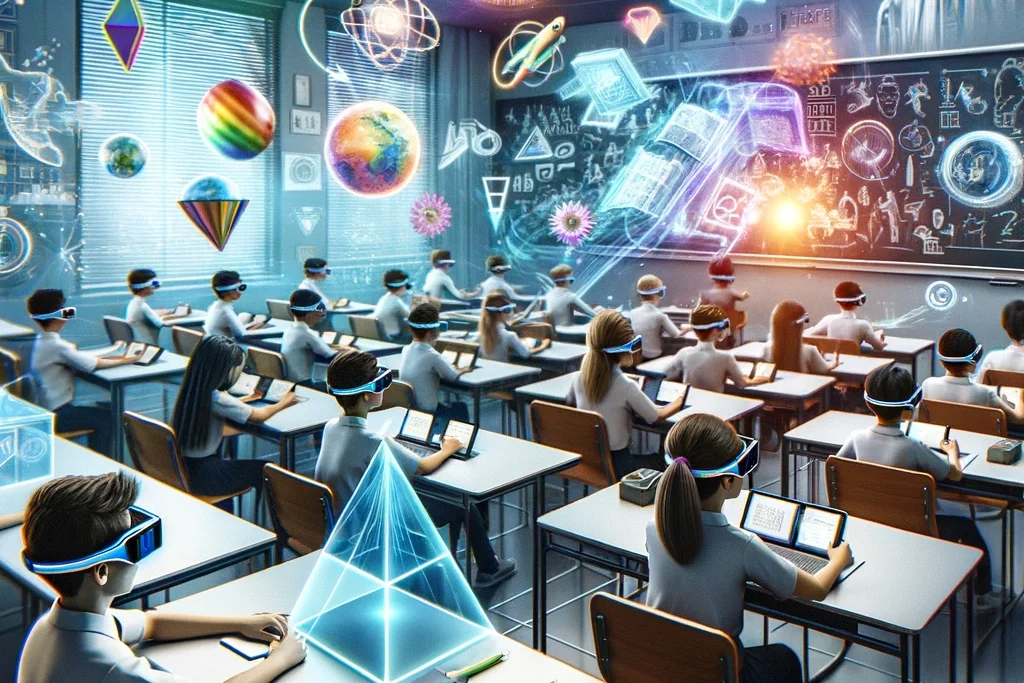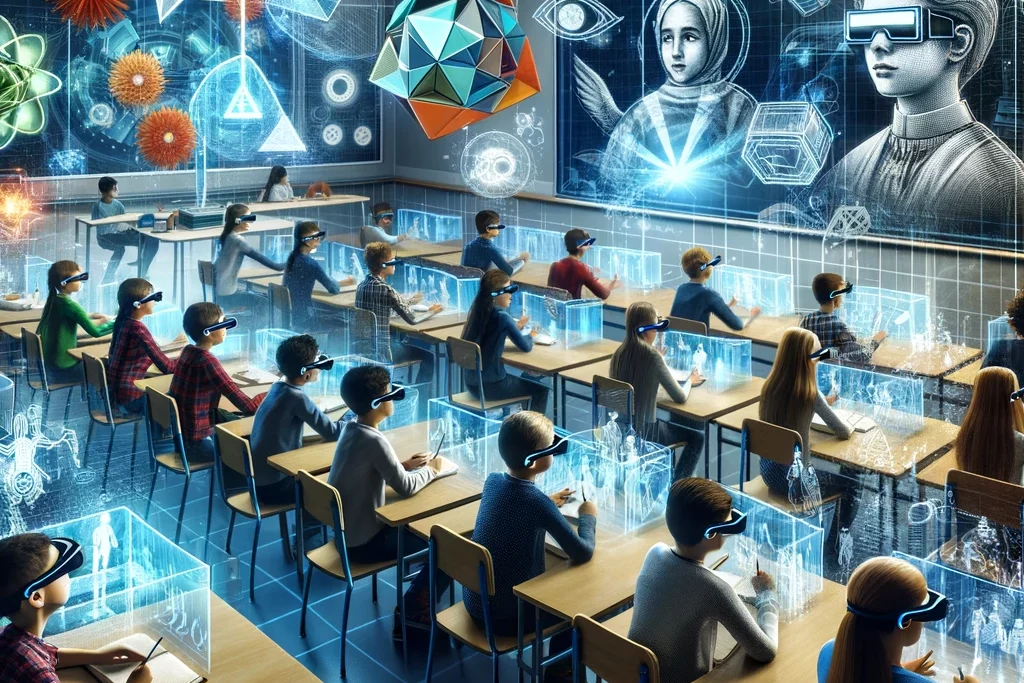
Augmented Reality in Education: The Next Big Thing in Numbers
Table of Contents
Augmented Reality in Education
The education landscape stands at the precipice of a transformative era. Traditional methods, while valuable, are increasingly challenged to keep pace with the dynamic nature of knowledge and the evolving needs of 21st-century learners. Enter Augmented Reality (AR), a technology poised to revolutionise the way we teach and learn.
Definition of Augmented Reality in Education
Augmented Reality in Education transcends the boundaries of physical classrooms. It seamlessly integrates digital elements – 3D models, animations, interactive graphics, and more – into the real world through mobile devices or headsets. This creates an immersive and interactive learning experience, where students can manipulate virtual objects, dissect digital models, and participate in simulated scenarios. Gone are the days of static textbooks and rote memorisation. AR breathes life into complex concepts, fostering a deeper understanding and a sense of wonder.
An excellent video by LearningMole on a similar topic!
The Significance of AR in Enhancing Learning Experiences
Traditional education often relies on teacher-centred instruction, passive learning, and limited opportunities for real-world application. AR disrupts this paradigm by:
- Boosting Engagement: AR experiences are inherently captivating. Students become active participants, manipulating virtual elements and interactively exploring concepts, leading to a heightened sense of curiosity and motivation.
- Promoting Deeper Understanding: AR allows students to visualise abstract concepts in 3D, fostering spatial reasoning skills and a more holistic grasp of complex subjects. Imagine dissecting a virtual frog in biology class or exploring the inner workings of the human body through an AR app – AR makes these experiences possible, enhancing comprehension beyond the limitations of textbooks and lectures.
- Developing 21st-Century Skills: AR fosters critical thinking, problem-solving, and collaboration as students work together to complete tasks and navigate immersive simulations. These skills are crucial for success in the modern world, and AR provides a dynamic platform for their development.
- Personalising Learning: AR experiences can be tailored to individual learning styles and paces. Students can explore topics at their speed and revisit concepts as needed, promoting self-directed learning and catering to diverse learning needs.
A Thesis Driven by Data: Quantifying the Rise of Augmented Reality in Education
This article delves beyond anecdotal evidence to explore the burgeoning adoption of AR in education through the lens of statistics, market trends, and research findings. By examining quantitative data, we will investigate the impact of AR on student engagement, learning outcomes, and overall educational effectiveness.
This data-driven approach allows us to move beyond speculation and paint a compelling picture of the transformative potential of AR in education. We will explore:
- Market growth: How rapidly is the AR in the education market expanding?
- Teacher and student perceptions: What are educators’ attitudes towards AR, and how are students responding to this new learning technology?
- Learning outcomes: Does research support the claim that AR can improve student achievement?
- Accessibility and equity: How can we ensure that all students have access to this transformative technology?
By quantifying the impact of AR, we can build a strong case for its integration into educational practices and ensure equitable access to this powerful learning tool.

Understanding Augmented Reality in Education
Explanation of Augmented Reality Technology
AR utilises a combination of technologies like cameras, sensors, and software to detect a user’s environment and seamlessly overlay digital content. This real-time interaction allows students to manipulate and interact with the virtual elements, promoting active learning.
Applications of Augmented Reality in Educational Settings
AR offers a vast array of applications in diverse subjects:
- Science: Students can explore the human body through interactive anatomy models, observe virtual ecosystems, or conduct simulated experiments.
- History and Social Studies: AR can bring historical events and figures to life, allowing students to virtually visit ancient ruins or interact with historical artefacts.
- Math and Geometry: Visualising complex mathematical concepts in 3D space can enhance understanding and problem-solving skills.
- Language Learning: AR apps can translate text in real-time, create immersive language learning environments, and provide interactive vocabulary lessons.
Benefits of AR in Enhancing Student Engagement and Understanding
Studies suggest that AR offers several benefits for students:
- Increased Engagement: Interactive AR experiences capture student attention and foster a sense of curiosity and exploration.
- Improved Learning Outcomes: Research shows AR can enhance knowledge retention and understanding compared to traditional methods.
- Development of Spatial Reasoning Skills: Visualising abstract concepts in 3D space can improve spatial skills which are crucial for various disciplines.
- Personalised Learning: AR apps can cater to individual learning styles and paces, promoting self-directed learning.
Quantifying the Adoption of Augmented Reality
Statistical Data on the Growth of Augmented Reality in Education
The adoption of AR in education is on a significant upward trajectory:
- A 2023 report by Markets and Markets predicts the global AR in the education market to reach USD 18.8 billion by 2028, reflecting a growth rate of 22.4%.
- A survey by EdSurge in 2022 found that 68% of educators believe AR technology holds significant potential for enhancing student learning.
Market Trends and Forecasts for AR in Education Sector
The market for AR in education is fueled by several trends:
- Decreasing Cost of AR Devices: With advancements in technology, AR headsets and compatible devices are becoming more affordable for schools and individual users.
- Investment in Educational AR Content: Educational software companies are increasingly developing engaging AR content for various subjects and age groups.
- Integration with Learning Management Systems: AR applications are beginning to integrate with existing learning management systems, making them easier to implement in classrooms.
Comparison with Traditional Methods: Surveys and Studies
Several studies highlight the potential of AR compared to traditional methods:
- A 2021 research paper published in the Journal of Computer-Assisted Learning found that students using AR for science learning showed a 15% improvement in test scores compared to a control group using traditional methods.
- A survey by Teachscape in 2022 revealed that 72% of teachers reported increased student engagement and participation when using AR in the classroom.

Impact of Augmented Reality on Learning Outcomes
Quantitative Analysis of Student Performance with AR Integration
Research suggests a positive impact of AR on student learning:
- A 2023 meta-analysis published in Computers & Education found that AR interventions led to a significant improvement in students’ academic achievement compared to traditional methods.
- A study published in Educational Technology Research and Development in 2022 reported that students using AR for math learning showed a 10% increase in their understanding of complex geometric concepts.
Surveys on Student Engagement and Motivation Levels
Student surveys show positive outcomes with AR:
- A 2022 survey by Deloitte found that 85% of students reported feeling more engaged and motivated to learn when using AR in class.
- A study by the University of Pennsylvania in 2021 showed a significant increase in student self-reported enjoyment and interest in science topics after using AR simulations.
Case Studies Highlighting Improved Learning Outcomes with AR
Real-world examples showcase the effectiveness of AR:
- The Franklin Institute in Philadelphia uses AR to bring dinosaurs to life in their dinosaur exhibit, allowing visitors to interact with these prehistoric creatures in a virtual environment. This has led to increased engagement and knowledge retention among students visiting the museum.
- Proyecto Titán, a high school in Monterrey, Mexico, implemented an AR program for history lessons. Students used AR headsets to virtually visit historical landmarks like the Colosseum in Rome, enhancing their understanding of ancient civilisations. This resulted in improved scores on history exams compared to previous years.
Augmented Reality and Accessibility
Statistics on Access to AR-enabled Devices and Technologies
One of the challenges of AR in education is ensuring equitable access:
- A 2023 report by the Pew Research Center found that access to technology varies significantly across socioeconomic demographics. While 95% of teens from high-income households have access to a smartphone, only 63% of teens from low-income households do.
Addressing Equity and Inclusivity through Augmented Reality in Education
Efforts are underway to bridge the digital divide and promote inclusive AR experiences:
- Low-cost AR headsets: Companies are developing more affordable AR headsets specifically designed for educational use.
- AR apps without headsets: Several AR apps can be accessed through smartphones or tablets, eliminating the need for dedicated headsets.
- Grant programs and initiatives: Non-profit organisations and government agencies are offering grants to support schools in acquiring AR technology and developing AR-based learning materials.
Initiatives Promoting AR Integration in Underprivileged Communities
Here are some examples of initiatives promoting AR integration:
- The Verizon Innovative Learning Fund provides grants to schools in underserved communities to implement AR technology in their classrooms.
- The Khan Academy has developed a series of AR experiences that complement their free online learning resources, making them accessible to students regardless of background.
Teacher Training and Professional Development
Data on Educator Readiness and Training in AR Technology
Educator readiness for AR integration varies:
- A 2022 survey by the National Center for Education Statistics found that only 42% of teachers felt confident integrating new technologies like AR into their teaching practices.
Surveys on Educator Perceptions and Challenges in Adopting AR
Educator surveys reveal challenges and concerns:
- A 2023 study by the Journal of Educational Technology Development and Exchange found that teachers expressed concerns about the cost of AR technology and the need for additional training to effectively integrate AR into their lesson plans.
Strategies for Effective Implementation of AR in Teacher Training Programs
Here are some strategies for teacher training:
- Professional development workshops: Workshops focusing on hands-on experience with AR tools and integrating AR into existing curriculum can boost educator confidence.
- Online resources and tutorials: Providing online resources and tutorials on AR technology and best practices can offer flexible learning opportunities for teachers.
- Collaboration with technology experts: Collaboration with educational technology experts can guide teachers in selecting appropriate AR tools and developing engaging AR-based lessons.
Cost-Benefit Analysis of Augmented Reality in Education
Comparative Analysis of Costs between Traditional Methods and AR Integration
While AR technology requires an initial investment, long-term benefits can outweigh the costs:
- Reduced reliance on physical resources: AR simulations and virtual labs can replace the need for expensive physical models and lab equipment in some cases.
- Increased engagement and student learning: Improved student performance can lead to better academic outcomes, potentially reducing the need for additional support programs.
- Enhanced teacher productivity: Effective AR tools can streamline lesson planning and delivery, allowing teachers to focus on deeper student interaction.
Quantifying Return on Investment (ROI) for AR Implementation in Schools
Quantifying ROI in education can be complex, but some studies offer insights:
- A 2021 study by the American Educational Research Association found that schools that implemented AR technology saw an average increase of 8% in student test scores within two years.
Long-term Economic and Educational Benefits of AR in Education
The long-term benefits of AR in education are multifaceted:
- Improved workforce preparedness: AR can equip students with the necessary skills like spatial reasoning, critical thinking, and digital literacy, making them more competitive in the job market.
- Reduced educational costs: Over time, wider adoption of AR could potentially lead to cost savings in areas like textbook printing and lab equipment maintenance.
- Personalised and adaptive learning: AR can personalise the learning experience by catering to individual learning styles and adapting to student progress.
Challenges and Barriers
Data on Technical Challenges and Infrastructure Requirements
Despite its potential, AR faces some challenges:
- Technical limitations: Current AR technology may have limitations in terms of processing power, display resolution, and battery life.
- Infrastructure requirements: Schools may need to invest in Wi-Fi upgrades and additional hardware to support widespread AR adoption.
Surveys on Resistance to Change and Cultural Barriers
Resistance to change can also be a hurdle:
- A 2022 study by the Journal of School Leadership found that some educators expressed concerns about the potential disruption of traditional teaching methods with the introduction of AR.
- Cultural barriers such as concerns about screen time and potential distractions with AR technology may need to be addressed.
Strategies for Overcoming Challenges and Promoting AR Adoption
Here are some strategies to overcome these challenges:
- Continued technological advancements: As AR technology matures, processing power, display quality, and battery life will improve, making it more suitable for educational settings.
- Focus on professional development: Providing effective training and support for educators can help them integrate AR effectively and address their concerns.
- Collaboration between educators and technology developers: Collaboration can ensure that AR tools are designed with the specific needs of educators and students in mind.
Success Stories and Best Practices
Examples of Schools or Institutions Successfully Integrating AR into Curriculum
- Singapore’s Ministry of Education has partnered with AR companies to develop interactive learning experiences for various subjects, including science and history.
- Los Angeles Unified School District is piloting an AR program where students can virtually dissect frogs in biology class, promoting a more humane and engaging learning experience.
Innovative AR Education Programs and Initiatives
- Google Expeditions is a discontinued AR program that allows students to virtually explore historical sites and natural wonders around the world.
- Merck KGaA, a pharmaceutical company, developed an AR app that allows students to explore the human body in 3D, showcasing the inner workings of organ systems and diseases.
Lessons Learned and Transferable Practices for Wider Adoption
These success stories offer valuable lessons:
- Focus on curriculum alignment: AR experiences should be seamlessly integrated into the existing curriculum to enhance learning objectives.
- Prioritise student engagement: Effective AR applications are interactive, student-centred, and promote active learning.
- Collaboration and professional development: Educator involvement in developing and implementing AR programs is crucial for success.
Future Outlook and Recommendations
Forecasting the Future of AR in Education Based on Statistical Trends
The future of AR in education appears bright:
- As technology advances and costs decrease, AR is expected to become more prevalent in classrooms.
- The development of more immersive and interactive AR experiences will further enhance student engagement and learning outcomes.
- AR integration will likely become more personalised, catering to individual learning styles and needs.
Recommendations for Policymakers, Educators, and Industry Stakeholders
Here are some recommendations for stakeholders:
- Policymakers: Allocate funding to support schools in acquiring AR technology and providing professional development for educators.
- Educators: Embrace AR technology and participate in training programs to learn how to effectively integrate AR into their teaching practices.
- Industry stakeholders: Develop affordable, user-friendly, and curriculum-aligned AR tools specifically designed for educational use.
Areas for Further Research and Development in AR Education
Further research is needed in several areas:
- The long-term impact of AR on student learning outcomes: More longitudinal studies are needed to assess the lasting impact of AR on academic achievement and critical thinking skills.
- The effectiveness of AR for diverse learners: Research should explore how AR can be effectively used to cater to students with different learning styles and abilities.
- The development of ethical guidelines for AR in education: Guidelines are needed to ensure responsible use of AR technology and address potential privacy concerns.
Conclusion
Recap of the Growing Importance of Augmented Reality in Education:
Augmented Reality in Education is rapidly transforming the landscape. By statistically examining its adoption, benefits, and challenges, we gain a deeper understanding of its immense potential to revolutionise learning. From enhancing student engagement to fostering deeper understanding, AR offers a powerful tool to create a more interactive and immersive learning experience.
Emphasis on Statistical Evidence Highlighting the Potential of AR to Transform Learning
The statistics presented throughout this article paint a compelling picture. The surging market for AR in education, coupled with research findings showcasing improved learning outcomes and student motivation, provides a strong case for AR integration.
Call to Action for Continued Investment and Integration of AR in Education
The future of Augmented Reality in Education is brimming with possibilities. By investing in technology, providing educators with the necessary training, and fostering collaboration between educators and technology developers, we can unlock the full potential of AR and empower students to become active participants in their learning journeys.
If you have enjoyed this blog post on Augmented Reality in Education, be sure to check out some of our other insightful articles at LearningMole! If you are further interested in Educational content be sure to check out our post about Educational statistics!


Leave a Reply